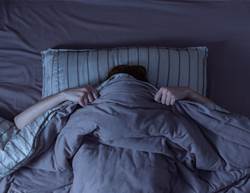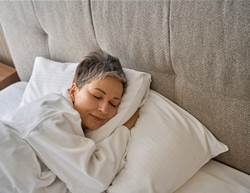As World Sleep Day dawns on 15 March, we’re once again waking up to the fact that Aussies and restful sleep are pretty incompatible bedfellows. According to the Sleep Health Foundation, almost 60% of us experience at least one chronic sleep symptom (such as trouble falling or staying asleep) that is stopping us from living healthy, happy lives.
The research also found that significantly more females than males (31% versus 21%) reported “often or always” worrying about getting a good night’s sleep and being overwhelmed by thoughts when trying to sleep (35% versus 25%).
Meanwhile, the potentially deadly sleep disorder sleep apnoea can occur in up to 25% of adults, with the vast majority of cases undiagnosed. Anyone who struggles with quality shut-eye knows just how debilitating it can be – just ask Dr Michael Mosley.
The celebrity doctor, who co-hosted Australia’s Health Revolution on SBS a few years ago and also spearheaded the intermittent fasting movement, is now turning his attention to sleep – and with good reason. A long-time insomnia sufferer himself since becoming a father in his late 30s, Dr Mosley knows all too well the havoc it can cause in one’s life.
“You’re irritable, you’re not engaging with your friends and family as much as you’d like to; it’s just a remorseless grind,” he says.
Having just finished writing the book 4 Weeks To Better Sleep, Dr Mosley was also keenly aware of the long-term implications of disturbed slumber.
“I developed type 2 diabetes 12 years ago,” he shares. “I managed to get rid of it, but I always thought it would lurk there. And I knew bad sleep is linked with diabetes, but also low mood and increased risk of things, such as heart disease, dementia and memory loss, down the track.”
In the new SBS series Australia’s Sleep Revolution with Dr Michael Mosley, the doctor and a crack team from Australia’s Flinders University Sleep Institute tracked 30 of the nation’s poorest sleepers – Dr Mosley included – in a groundbreaking new sleep study, using a multi-disciplinary, holistic approach to analyse each participant’s deep-seated sleep issues.
“What the scientists are doing is trying to develop a program, which can be rolled out nationwide and help the GPs who are struggling with patients who have sleep problems,” Dr Mosley explains. “Doctors haven’t been trained in how to deal with sleep problems, and they don’t know what to do with them apart from giving [patients] medication.
“The point of this documentary is to say, ‘Look, here’s something that actually works. It’s going to take a few weeks, but it’ll work. And in a significant number of cases, it’ll cure you. It’ll cure your insomnia; we can sort out your sleep apnoea.”
Bossing your body clock with chronotypes
A key aspect of tracking the patients in the Australian sleep study using new technologies was being able to determine their chronotype. This is your body’s natural preference to be alert and/or fall asleep at a certain time, based on your unique circadian rhythm or internal clock.
Flinders University sleep scientist Dr Sutapa Mukherjee, a senior respiratory and sleep physician, explains: “Some people are morning people. Others are evening people; they’re the night owl. To some extent, our genetics tells us where we’ll land in terms of chronotype. But then you can modify that a bit with things like our jobs. For example, many people are shift workers, so perhaps they’re night owls, but they have to get up really early for work. So those other factors will impact on your chronotype.”

Which chronotype are you?
All this chronotype talk probably has you wondering what the different groupings are and where you fit in. Most research divides people into the following three:
Morning lark: early birds naturally rise at 5 or 6am without an alarm and are ready for bed by about 9 or 10pm. At the extreme end are those who wake up at 3 or 4am and find it very difficult to stay up past 7pm; they may be diagnosed with advanced sleep phase disorder, explains Dr Erin Flynn-Evans, a sleep and circadian researcher.
Hummingbird: The majority of people fit in here. There are variations in morning-ness and evening-ness among this group, but hummingbirds take a little time to warm up and then hover midday before slowing down toward the end of the day, says Dr Natalie Dautovich, a psychologist specialising in sleep.
Night owl: A typical night owl is still activated at midnight and really struggles to wake up at 7 or 8am, says Dr Flynn-Evans. At the extreme end, someone who easily stays awake until 4 or 5am and sleeps until 12 or 1pm may be diagnosed with delayed sleep phase disorder, she adds.
To get a clearer idea of your chronotype without seeing a specialist, you can take the Automated Morningness-Eveningness Questionnaire (AutoMEQ) online (costs $3US).
Insomnia treatments that work
Taking part in the experiment was, for Dr Mosley, eye-opening in more ways than one. While he knew he had insomnia, he was surprised by the revelation that his body clock had shifted forward in the extreme, with an advanced sleep phase diagnosis. He was treated with light therapy by exposing him to bright light in the evening.
Other poor sleepers on the trial were offered a variety of methods to combat their issues, a pivotal one of which was cognitive behavioural therapy, an intensive therapy administered by a psychologist that incorporates elements of good sleep hygiene and close monitoring of the factors causing the issues.
Another important aspect of this is bedtime restriction therapy, “where you cut down the amount of time you spend in bed, so that you spend more of that time asleep.”
How to get better quality sleep
A solid forty winks is there for the taking – you just need the right preparation. Here, Dr Sutapa Mukherjee reveals the essential habits that’ll get you there.
1. Limit screen time before bed
“One of the main things that’s playing havoc with people’s sleep is the use of screens and devices before bedtime. When I was a child, at most we had a television, and the test pattern used to come on at 10.30 or 11pm and then you couldn’t even watch TV! But now we’ve got these electronic devices literally next to us when we’re relaxing, often more than one, emitting large amounts of light.
“Light is a really important stimulator helping us to stay awake. So, I would always recommend people turn off their devices at least an hour before they want to be asleep.”
2. Dim lights from 8pm onward
“I’m trying to tell my body that I’m now getting ready for bedtime. So, again, I don’t want too much bright light before I’m trying to go to sleep.
3. Keep a regular sleep pattern
“Try to go to bed and get out of bed at a set time, and avoid changing it from one day to the next, including weekends and days off. That really helps to regulate the sleep cycle.”
4. Minimise caffeine and alcohol
“Some people say alcohol helps them to go to sleep, but in effect it actually lightens your sleep for the rest of the night. So, you may actually wake up more. Caffeine, of course, can be very stimulatory, especially when consumed later in the day.”
5. Think about when you’re eating
“Some people actually get hungry before bedtime, which can keep them awake. For example, if you have your evening meal between 5–6pm, and you’re trying to go sleep at midnight, then you might benefit from having a snack or a milk drink [milk contains high levels of the sleep-promoting essential amino acid tryptophan], to have something in your stomach before you nod off.
"Obviously, trying to go to sleep when you’ve had a big meal is also almost impossible, so it’s important to allow a few hours between your evening meal and when you’re ready for bedtime.”
6. Don’t exercise too late
“Morning exercise, lunchtime exercise, even up to about 6pm is good and can help you get to sleep and stay asleep. But, for some, physical activity will cause endorphins to be released, and other hormones, such as adrenaline and noradrenaline, which can wire you up and make you more stimulated.”
7. Next-gen apnoea gadgets
Perhaps the biggest revelation for Dr Mosley was the discovery that he also had severe sleep apnoea, the combination of two sleep disorders known as comorbid insomnia and obstructive sleep apnoea (COMISA).
“COMISA means you have two sleep problems, and they amplify each other,” Dr Mosley explains. “So, if you have insomnia, and you also have sleep apnoea, it significantly raises your risk of heart disease, dementia, all the bad stuff. The impact can be quite devastating.”
But there’s good news for those who don’t want to use a CPAP machine – two new treatment methods are now on offer.
“One is a mouthguard, which brings the jaw forward,” says Dr Mosley. “That means the tongue doesn’t fall back and block your airways. The other treatment is a device that you put around your neck and it buzzes you when you’re lying on your back, which is when sleep apnoea most commonly happens.”
For the full article, grab a copy of the April 2024 issue of Prevention Australia, on newsstands from 11 March.








_(1)_11zon_(1).jpg&h=193&w=250&c=1&s=1)
